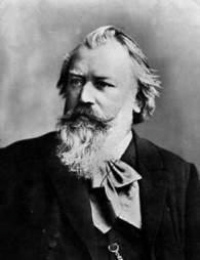Brahms
 Johannes Brahms (May 7, 1833 â April 3, 1897) was a German composer of the Romantic period. He was born in Hamburg and in his later years he settled in Vienna, Austria.
Johannes Brahms (May 7, 1833 â April 3, 1897) was a German composer of the Romantic period. He was born in Hamburg and in his later years he settled in Vienna, Austria.Brahms maintained a Classical sense of form and order in his works â in contrast to the opulence of the music of many of his contemporaries. Thus many admirers (though not necessarily Brahms himself) saw him as the champion of traditional forms and "pure music," as opposed to the New German embrace of program music.
Brahms venerated Beethoven: in the composer's home, a marble bust of Beethoven looked down on the spot where he composed, and some passages in his works are reminiscent of Beethoven's style. The main theme of the finale of Brahms's First Symphony is reminiscent of the main theme of the finale of Beethoven's Ninth, and when this resemblance was pointed out to Brahms he replied that any ass â jeder Esel â could see that.
Ein deutsches Requiem was partially inspired by his mother's death in 1865, but also incorporates material from a Symphony he started in 1854, but abandoned following Schumann's suicide attempt. He once wrote that the Requiem "belonged to Schumann". The first movement of this abandoned Symphony was re-worked as the first movement of the First Piano Concerto.
Brahms also loved the Classical composers Mozart and Haydn. He collected first editions and autographs of their works, and edited performing editions. He also studied the music of pre-classical composers, including Giovanni Gabrieli, Johann Adolph Hasse, Heinrich Schütz and especially Johann Sebastian Bach. His friends included leading musicologists, and with Friedrich Chrysander he edited an edition of the works of François Couperin. He looked to older music for inspiration in the arts of strict counterpoint; the themes of some of his works are modelled on Baroque sources, such as Bach's The Art of Fugue in the fugal finale of Cello Sonata No. 1, or the same composer's Cantata No. 150 in the passacaglia theme of the Fourth Symphony's finale.
 Brahms Latest Sheets Feed
Brahms Latest Sheets Feed Brahms Latest Requests Feed
Brahms Latest Requests Feed
Advertisement
Advertisement
Total 915 sheet(s) found, listing between 560 - 580.
| Song | Added By | Pages | Instruments | Sheet Type | File |
| Hungarian Dance No. 5 |
1qaz2wsx (4)
5063d ago
|
5 | Piano | Original |
|
| Cello Sonata In Em |
vannielou622 (6)
5064d ago
|
11 | Cello | Original |
|
| trio |
s.maralbashi (10)
5065d ago
|
2 | Piano, Cello, Clarinet | Transcription |
|
| Hungarian Dance No. 5 in F sharp Minor for solo piano |
tfg004 (1)
5065d ago
|
3 | Piano | Transcription |
|
| lieder op 105 |
cellogirl (4)
5065d ago
|
26 | Piano, Vocal | Original |
|
| 5 songs |
cellogirl (4)
5065d ago
|
5 | Piano, Vocal | Original |
|
| Variations on a Theme by Paganini Book II Op 35 pt 2 |
sparky76 (2)
5065d ago
|
16 | Piano | Book |
|
| Variations on a Theme by Paganini book I |
sparky76 (2)
5065d ago
|
15 | Piano | Book |
|
| Brahms' exersices |
jokorta (8)
5066d ago
|
53 | Piano | Original |
|
| All meine Herzgedanken |
jeff143 (15)
5067d ago
|
5 | Vocal | Transcription |
|
| 51 Exercises |
Rothbart (2)
5067d ago
|
53 | Piano | Book |
|
| Hungarian Dance No 5 |
adrianna (2)
5068d ago
|
4 | Piano, Violin | Other |
|
| Sonata in Em (Op 38) |
ray_stizz (1)
5069d ago
|
6 | Cello | Other |
|
| Op 39 n.3 |
andyinformatica (9)
5070d ago
|
1 | Piano | Original |
|
| Double concerto-iii |
chircu (31)
5070d ago
|
24 | Cello, Drum, Trumpet, Violin, Clarinet, Flute, Viola, Bass, Trombone, Oboe, Bassoon, Timpani, Percussion | Original |
|
| Double concerto-ii |
chircu (31)
5070d ago
|
8 | Cello, Drum, Trumpet, Violin, Flute, Viola, Horn, Bass | Original |
|
| Double concerto-I |
chircu (31)
5070d ago
|
36 | Cello, Drum, Trumpet, Violin, Clarinet, Flute, Viola, Horn, Bass | Original |
|
| hungarian Dances Nº5 |
mramirezguru (3)
5071d ago
|
2 | Violin | Original |
|
| hungarian dances |
mramirezguru (3)
5071d ago
|
10 | Piano, Violin | Original |
|
| Hungarian Dance No. 5 |
nsonnenfeld1 (1)
5072d ago
|
2 | Violin | Transcription |
|

